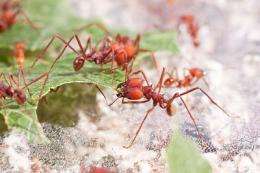Leafcutter ant genome reveals secrets of fungus farming ways

Leafcutter ants, signature denizens of New World tropical forests, are unique in their ability to harvest fresh leaves to cultivate a nutrient-rich fungus as food.
Now, this mutualism -- a complicated interplay of ants, fungi and a suite of bacteria -- is coming into sharper focus as a team of University of Wisconsin-Madison researchers has published the complete genome of the leafcutter ant, Atta cephalotes.
The study, published today (Feb. 10, 2011) in the journal Public Library of Science (PLoS) Genetics, by an international team led by UW-Madison bacteriology professors Cameron Currie and Garret Suen, illustrates how lifestyle can remake an animal's genetic blueprint over the course of evolutionary history.
The genome, the first for a leafcutter ant, reveals that the insect has shed genes that other ant species use to help acquire nutrients. The leafcutter, which cannot survive without its fungus food, has apparently slimmed its genome to get rid of genes it no longer needs due to its symbiotic lifestyle.
"Presumably, the ants have lost these genes because of their dependency on the fungus," explains Wisconsin researcher Garret Suen, the lead author of the PLoS Genetics study. "They don't need these proteins kicking around any more."
Over the course of 50 million years, leafcutters and their fungus food have evolved a mutualism that enables the ants to become the insect kingdom's most successful agronomists by cultivating huge subterranean fungus gardens that are the sole source of nutrition for enormous colonies containing millions of individuals.
In the New World tropics, the only place on Earth where the estimated 45 species of leafcutters are found, the ants exert a pervasive ecological influence, harvesting as much as 17 percent of total leaf production in tropical rainforests and consuming more plants by volume than any other herbivore, including other insects and mammals. A mature colony can occupy 600 cubic meters of space.
Having the leafcutter genome in hand, say Currie and Suen, means that the evolutionary secrets of one of the most successful partnerships in nature can begin to be read in the DNA of the ant.
The project was accomplished with the support of a Roche Applied Science grant for sequencing the estimated 300 million base pairs of DNA that make up the ant's genome. The grant, which includes access to Roche sequencing technology, is now supporting the generation of genome sequences for the fungus the ant eats, as well as for a cartel of microorganisms associated with both ant and fungus.
"The opportunity to study the symbiosis is what motivated us," says Currie. "The genome allows us to understand interactions in this insect-microbial system. It improves our ability to understand the evolution of symbiosis and fungus farming in ants in a major way."
Beyond identifying the genetic signatures of the leafcutter's fungus farming ways, there are other secrets the genome will reveal as the Wisconsin group has only scratched the surface of analyzing the massive amounts of data generated for the study.
Leafcutters, for example, are known for having a diversity of body shapes and sizes to accomplish the division of labor it takes to build, defend and stock a nest containing so many individual insects. The ant's caste system, for example, includes small workers for tending to the fungus garden and ant brood, medium-sized workers for harvesting fresh leaves, and larger soldiers; those capable of mating, have wings.
"A genome gives you a blueprint of every single gene an organism contains," Suen notes, and, ultimately, it will yield all the tightly-held secrets of the ant's mutualistic behavior and the genetic differences that underpin the ant caste system that makes one ant small and another large.
More information: www.physorg.com/news/2011-01-a … successful-pest.html
Provided by University of Wisconsin-Madison


















